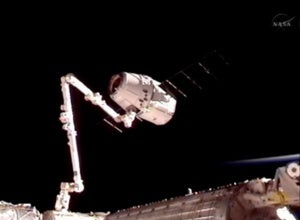
The era of commercial spaceflight has begun.
Early Friday morning SpaceX, a private company with less than 2,000 employees and and average age of 30, entered a domain that had until now been – literally and figuratively – occupied by big governments with really big budgets.
Their Dragon spacecraft successfully docked to the International Space Station, the first privately funded spacecraft to do so. But not without difficulty.
Before the Dragon was reeled in it performed a series of test maneuvers to show that it could be controlled from both the ground and the ISS. The first test included an approach towards the station. At some point astronaut Andre Kuipers sent it an abort command, after which the Dragon stopped its approach and returned to its hold position 250 meters from the station. But the test wasn’t a clean pass. Kuipers had sent a command for the Dragon to move to a position 235 meters away, but problems with the Dragon’s thermal camera made the gumdrop-shaped craft move to 250 meters away.
In another test, the Dragon’s LIDAR (light detection and ranging) sensors were fouled by reflections coming from the Japanese Kibo experiment module on the station, causing it to miscalculate its position. SpaceX engineers got around this by narrowing the LIDAR’s detection range and focusing on the path it would take to during its approach to the ISS. Mission control was still worried about the now-limited LIDAR and were prepared to abort should it fail.
But it didn’t. The Dragon, at a standstill 10 meters from the station, awaited as astronaut Don Pettit reached out to it with the robotic arm. Capture was confirmed at 6:56 a.m. PDT. For the next two hours the Dragon was slowly drawn towards the station. When it finally attached to a docking station at 8:52 a.m. over the skies of Australia, the Dragon became the first private spacecraft to deliver cargo to Earth orbit.

Pettit said, “Looks like we’ve got a Dragon by the tail,” and jubilant cheers erupted in mission control in Houston and SpaceX’s control center in Hawthorne, California.
The Dragon had brought 1,014 pounds (460 kilograms) of cargo, including food, water, and computers. Purposefully, none of the supplies are essential given that there was no assurance that the Dragon would successfully complete the trip. Also on board was an experiment devised by 14-year-old DC native Kyra Smith that the astronauts will perform to test if bacteria can be used to purify water. The astronauts will fill the Dragon with 1,367 pounds (620 kilograms) of cargo before sending it on its way back to Earth. The historic splashdown is planned for May 31 in the Pacific Ocean.
As routine as it may seem in an age where shuttle launches have long since ceased to be headline news, getting to space is still wrought with mishaps, delays, and occasionally disaster. The Dragon’s original launch date was planned for February 7, but was scratched due to a number of problems including software glitches. And last Saturday one of the Falcon 9 engines showed an unusual buildup of pressure, prompting the launch to be aborted just half a second before blastoff.
And SpaceX still has a lot of work to do if they’re going to be more than just a cargo lift. Transporting astronauts is vastly more technically challenging than transporting freeze-dried ice cream. But SpaceX founder Elon Musk, buoyed by the successful docking, is already talking about flying people to Mars, other planets, the stretch of the solar system. The indomitable Musk, who also designed the electric Tesla Roadster and was instrumental in the creation of the company which became Paypal, said SpaceX could be ready to fly astronauts by 2015. SpaceX will have to prove itself first, though, and they’re slated to begin doing just that this September with the first of 12 deliveries to the ISS contracted with NASA.
But maybe the best part of all this is that SpaceX is just one player in the larger movement towards the privatization of spaceflight. NASA is funding three other companies in addition to SpaceX to develop vehicles to fly astronauts to space. Orbital Sciences Corp plans on launching its Antares rocket and Cygnus capsule later this year.
The Dragon’s docking certainly marks a new era in spaceflight. No longer is it solely the provence of governments. But the shift in the spaceflight paradigm can be mapped to 2004, with Burt Rutan’s claiming of the Ansari X PRIZE. His SpaceShipOne became the first privately-built manned spacecraft to reach space. Instead of costing billions or needing a team of thousands, SpaceShipOne required just $26 million and thirty engineers. Rutan’s company, Scaled Composites, demonstrated that individuals can do the job just as good if not better and more cheaply than governments.
Wearing protective masks and goggles in case of lose debris, ISS commander Oleg Kononenko and astronaut Pettit opened Dragon’s hatch early Saturday morning and floated through. The Dragon and its contents were perfectly in order, and Pettit said it smelled “like a brand new car.” Fitting for the brand new era of spaceflight that the Dragon has also delivered.



